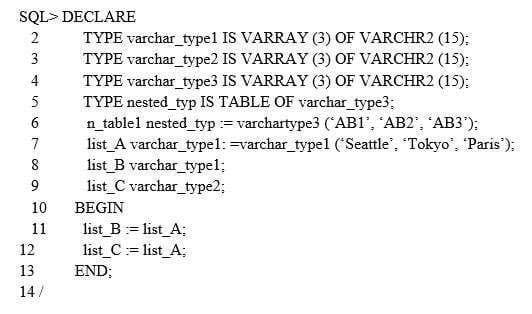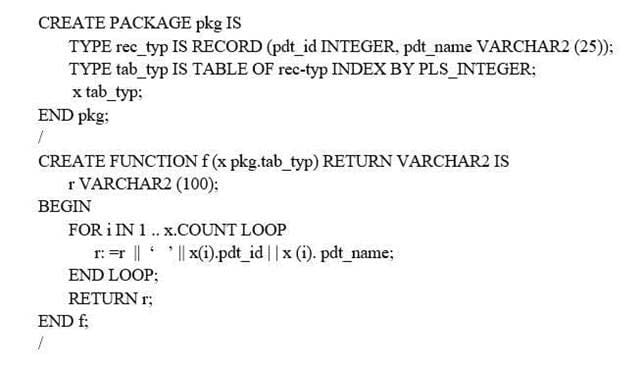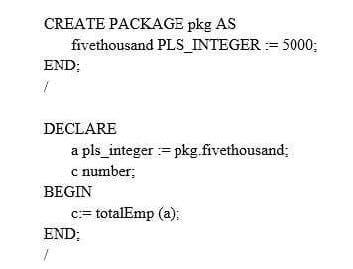Exam Details
Exam Code
:1Z0-148Exam Name
:Oracle Database: Advanced PL/SQLCertification
:Oracle CertificationsVendor
:OracleTotal Questions
:243 Q&AsLast Updated
:Jun 28, 2025
Oracle Oracle Certifications 1Z0-148 Questions & Answers
-
Question 81:
Which two statements are true about the DBMS_ LOB package?
A. DBMS_LOB.COMPARE can compare parts of two LOBs.
B. DBMS_LOB.COMPARE returns the size difference of the compared LOBs.
C. DBMS_LOB.COMPARE is overloaded and can compare CLOBs with BLOBs.
D. If the destination LOB is a temporary LOB, the row must be locked before calling DBMS_LOB.CONVERTTOBLOB.
E. Before calling DBMS_LOB.CONVERTTOBLOB, both the source and destination LOB instances must exist.
-
Question 82:
Which two statements are correct for collecting data about identifiers in PL/SQL source code?
A. CREATE < function/Procedure> PLSCOPE_SETTINGS = `IDENTIFIERS: ALL' AS ...
B. ALTER SYSTEM SET PLSCOPE_SETTINGS = `IDENTIFIERS: NONE'
C. ALTER SESSION SET PLSCOPE_SETTINGS = `IDENTIFIERS: NONE'
D. ALTER SESSION SET PLSCOPE_SETTINGS = `IDENTIFIERS: ALL'
E. ALTER
COMPILE PLSCOPE_SETTINGS = `IDENTIFIERS: ALL' -
Question 83:
You execute this PL/SQL block:

What will be the outcome?
A. It will fail compile because of errors at lines 11 and 12.
B. It will fail compile because of errors at lines 6 and 12.
C. It will fail compile because of error at line 7.
D. It will fail compile and execute successfully.
E. It will fail compile because of errors at lines 5 and 6.
-
Question 84:
Examine this function call:
cur_num := DBMS_SQL.TO_CURSOR_NUMBER (cur_val);
Which two statements are true?
A. CUR_VAL must be opened after this line is executed in the PL/SQL block.
B. CUR_VAL must be a weakly typed cursor variable.
C. CUR_VAL can be either a strongly or weakly typed cursor variable.
D. CUR_VAL must be opened before this line is executed in the PL/SQL block.
E. The PL/SQL block can continue to use the cursor variable after this line is executed.
-
Question 85:
Which three statements are correct with reference to intra unit inlining?
A. Inlining will always decrease the size of a unit.
B. Setting PLSQL_OPTIMIZE_LEVEL to 2 means automatic inlining is attempted.
C. You cannot inline an external subroutine.
D. Programs that make use of smaller helper subroutines are good candidates for inlining.
E. Pragmas apply only to calls in the next statement following the pragma.
F. You cannot inline local subroutines.
-
Question 86:
Examine the code:

Which two subprograms will be created successfully?
A. CREATE FUNCTION p4 (y pkg.tab_typ) RETURN pkg.tab_typ IS BEGIN EXECUTE IMMEDIATE ‘SELECT pdt_id, pdt_name FROM TABLE (:b)’ BULT COLLECT INTO pkg.x USING y; RETURN pkg.x;
END p4;
B. CREATE PROCEDURE p1 (y IN OUT pkg.tab_typ) IS BEGIN EXECUTE IMMEDIATE ‘SELECT f (:b) FROM DUAL’ INTO y USING pkg.x; END p1;
C. CREATE PROCEDURE p2 (v IN OUT VARCHAR2) IS BEGIN EXECUTE IMMEDIATE ‘SELECT f (:b) FROM DUAL’ INTO v USING pkg.x; END p2;
D. CREATE FUNCTION p3 RETURN pkg. tab_typ IS BEGIN EXECUTE IMMEDIATE ‘SELECT f (:b) FROM DUAL’ INTO pkg.x; END p3;
E. CREATE PROCEDURE p5 (y pkg. rec_typ) IS BEGIN EXECUTE IMMEDIATE ‘SELECT pdt_name FROM TABLE (:b)’ BULK COLLECT INTO y USING pkg.x; END p5;
-
Question 87:
Identify the two correct scenarios where a function can be optimized using the function result cache feature.
A. A function which inserts multiple records into a DEPARTMENTS table as part of one-time data setup for an HR application.
B. A function which accesses multiple tables and calculates the commission to be given to a sales representative based on the number of products sold by that representative.
C. A function which deletes all the records from an EMPLOYEES_AUDIT table based on their LOG_DATE.
D. A function which updates the SALARY of all the employees in an EMPLOYEES table by a fixed percentage based on their DESIGNATION.
E. A function which calculates the factorial of a given number without accessing any table.
-
Question 88:
Which data dictionary view contains the list of procedures and functions defined within package specification that you can execute?
A. ALL_SOURCE
B. ALL_DEPENDENCIES
C. ALL_OBJECTS
D. ALL_PROCEDURES
E. ALL_PLSQL_OBJECT_SETTINGS
-
Question 89:
Consider a function totalEmp () which takes a number as an input parameter and returns the total number of employees who have a salary higher than that parameter.
Examine this PL/SQL package AS

Which two definitions of totalEmp () result in an implicit conversion by Oracle Database on executing this PL/SQL block?
A. CREATE FUNCTION totalEmp (sal IN NUMBER) RETURN NUMBER IS total NUMBER :=0; BEGIN … RETUNRN total; END; /
B. CREATE FUNCTION totalEmp (sal IN NUMBER) RETURN NUMBER IS total NUMBER :=0; BEGIN … RETUNRN total; END; /
C. CREATE FUNCTION totalEmp (sal IN PLS_INTEGER) RETURN NUMBER IS total NUMBER :=0; BEGIN … RETUNRN total;
END;
/
D. CREATE FUNCTION totalEmp (sal IN BINARY_FLOAT) RETURN NUMBER IS total NUMBER :=0; BEGIN … RETUNRN total; END; /
E. CREATE FUNCTION totalEmp (sal IN POSITIVEN) RETURN NUMBER IS total NUMBER :=0; BEGIN … RETUNRN total; END; /
-
Question 90:
You created a PL/SQL function with the RESULT_CACHE clause, which calculates a percentage of total
marks for each student by querying the MARKS table.
Under which two circumstances will the cache for this function not be used and the function body be
executed instead?
A. When a user fixes incorrect marks for a student, with an update to the MARKS table, and then executes the function in the same session
B. When the amount of memory allocated for the result cache is increased
C. When the function is executed in a session frequently with the same parameter value
D. When the database administrator disables the result cache during ongoing application patching
E. When the maximum amount of server result cache memory that can be used for a single result is set to
0.
Related Exams:
1Z0-020
Oracle8i: New Features for Administrators1Z0-023
Architecture and Administration1Z0-024
Performance Tuning1Z0-025
Backup and Recovery1Z0-026
Network Administration1Z0-034
Upgrade Oracle9i/10g OCA to Oracle Database OCP1Z0-036
Managing Oracle9i on Linux1Z0-041
Oracle Database 10g: DBA Assessment1Z0-052
Oracle Database 11g: Administration Workshop I1Z0-053
Oracle Database 11g: Administration II
Tips on How to Prepare for the Exams
Nowadays, the certification exams become more and more important and required by more and more enterprises when applying for a job. But how to prepare for the exam effectively? How to prepare for the exam in a short time with less efforts? How to get a ideal result and how to find the most reliable resources? Here on Vcedump.com, you will find all the answers. Vcedump.com provide not only Oracle exam questions, answers and explanations but also complete assistance on your exam preparation and certification application. If you are confused on your 1Z0-148 exam preparations and Oracle certification application, do not hesitate to visit our Vcedump.com to find your solutions here.